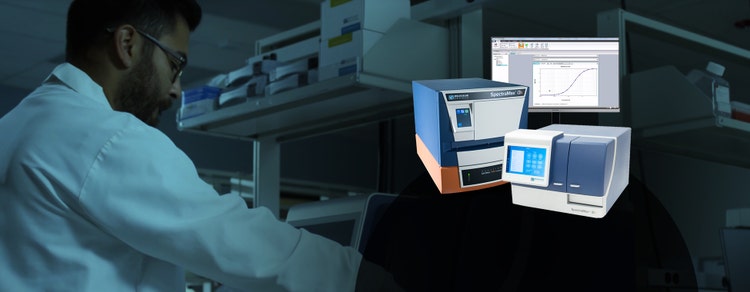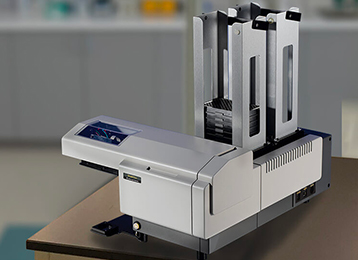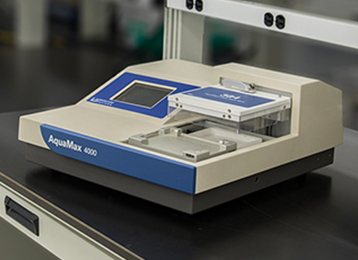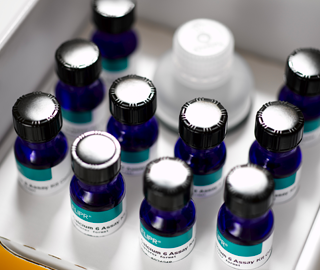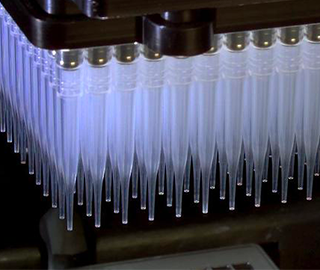Complete plate reader solution for all your research needs
For over 40 years, we have partnered with scientists to expand the boundaries of their research. Our SpectraMax microplate readers and SoftMax Pro software are the industry's most cited and have empowered life science researchers to advance protein and cell biology―breaking the barriers to novel, landmark discoveries.
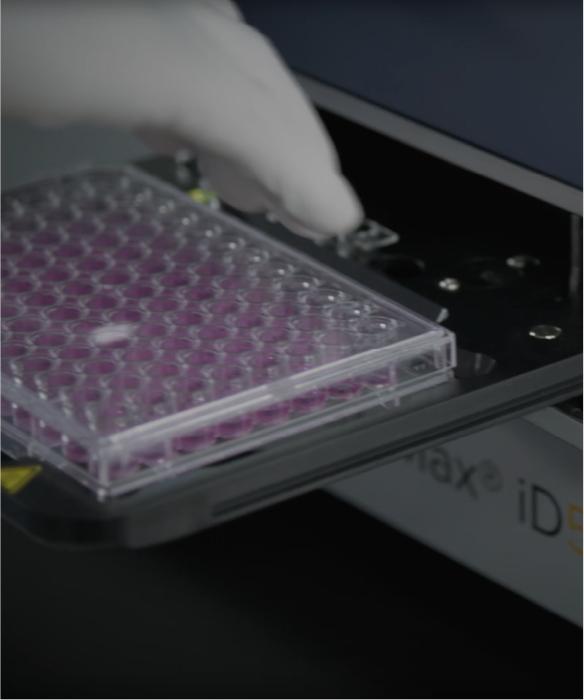
SpectraMax Microplate Readers

Our extensive SpectraMax® line of user-friendly microplate readers – the industry’s most cited brand – provide great flexibility for labs conducting applications ranging from ELISAs to nucleic acid and protein quantitation, and include absorbance, fluorescence, luminescence and more
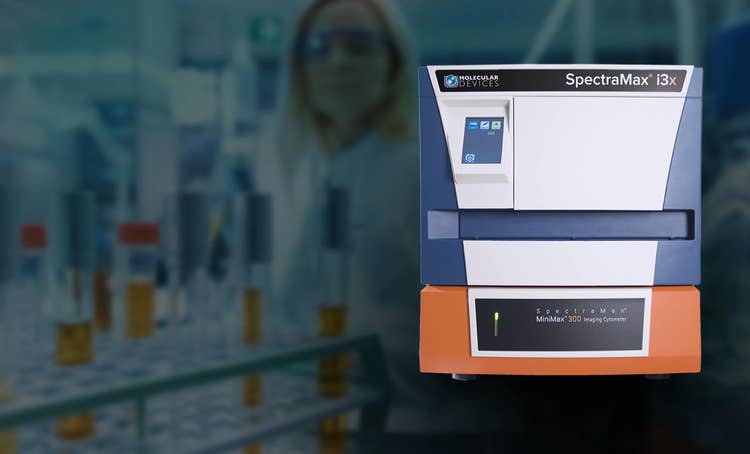
Multi-mode Microplate Readers
Our multi-mode plate readers provide great flexibility and include absorbance, fluorescence and luminescence with configurable options for fluorescence polarization (FP), time-resolved fluorescence (TRF), FRET, and AlphaScreen. Upgradeable modules are also available including western blot, cell imaging, and fast kinetics with injectors.
Single-mode Microplate Reader
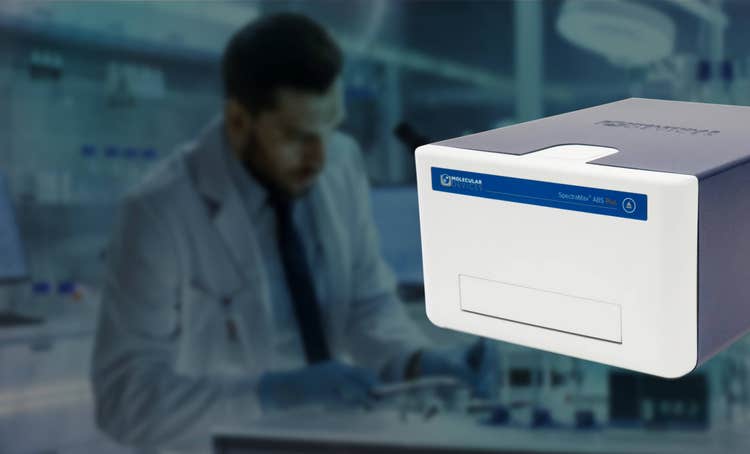
Consider your application needs, and if your budget is modest, a single-mode reader dedicated to your main application would be the most logical choice. The three most common detection modes include:
SoftMax Pro Software

SoftMax® Pro Software is the most published microplate reader control and data analysis software in the industry. Designed to provide the simplicity, flexibility and power required for advanced data analysis. It provides ready-to-run protocols, analysis algorithms, and 21 different curve fit options.
GxP Compliance & Validation Solutions
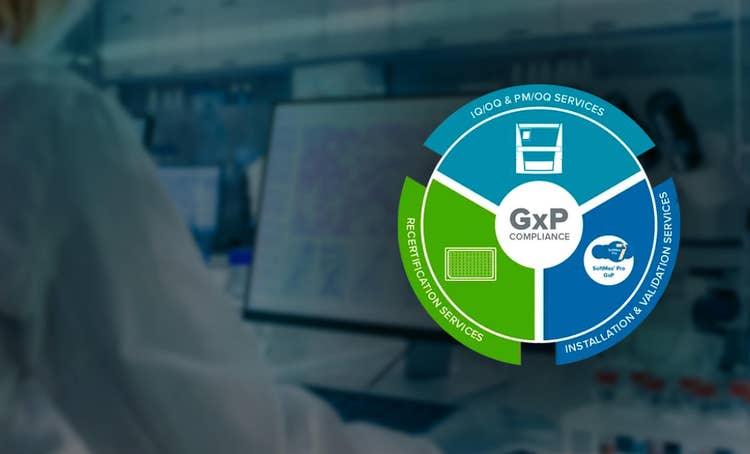
Our comprehensive suite of proven compliance solutions for GMP/GLP labs can advance your efforts to quickly and confidently establish a compliant laboratory.
- Best-in-class microplate readers and washers
- SoftMax Pro Software helps achieve full FDA 21 CFR Part 11 compliance
- Software installation services
- IQ/OQ/PM services
- SpectraTest Validation Plates and recertification
Lab Automation for Plate-based Assays
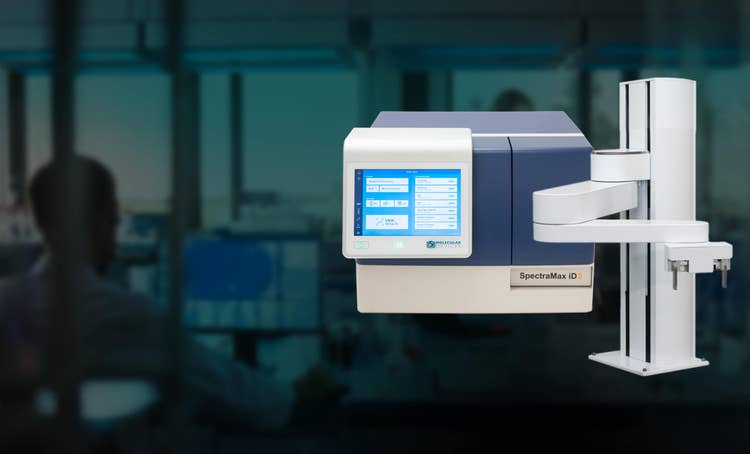
Plate-based assays form the cornerstone of many laboratory research programs. Whether you are performing biochemical assays, binding/affinity or cell-based assays we work with you to build flexible, scalable, future-proof workcells for high-throughput screening.
Which plate reader is right for you?
Evaluating microplate readers doesn’t have to be overwhelming. First, consider your application needs. If your budget is modest, a single-mode reader dedicated to your main application may be the most sensible choice. If you are working with—or anticipate exploring—a greater variety of applications, a multi-mode reader would be the better choice.
Explore our SpectraMax series of microplate readers
https://main--moleculardevices--hlxsites.hlx.page/products/series-products/spectramax-id5-readers
https://main--moleculardevices--hlxsites.hlx.page/products/series-products/spectramax-id3-readers
https://main--moleculardevices--hlxsites.hlx.page/products/series-products/spectramax-m2-m2e-readers
https://main--moleculardevices--hlxsites.hlx.page/products/series-products/spectramax-m4-reader
https://main--moleculardevices--hlxsites.hlx.page/products/series-products/spectramax-m5-m5e-readers
https://main--moleculardevices--hlxsites.hlx.page/products/series-products/filtermax-f3-readers
https://main--moleculardevices--hlxsites.hlx.page/products/series-products/filtermax-f5-readers
https://main--moleculardevices--hlxsites.hlx.page/products/series-products/gemini-em-readers
https://main--moleculardevices--hlxsites.hlx.page/products/series-products/gemini-xps-readers
Ultimate Guide to Microplate Reader Solutions
This eBook tells you everything you need to know about microplate readers, from plate reader technology and detection modes, to popular applications and key considerations, to GxP compliance for GMP/GLP labs and special tips and tricks to help maximize your research time.
Critical Considerations for Choosing the Right Microplate Reader
A microplate reader is an essential instrument for a vast range of applications, from basic ELISAs and DNA quantification to complex gene expression and enzyme kinetic assays. With so many options and functionalities available, it can be difficult to choose the optimal reader for your lab.
- Learn what features to look for when choosing a microplate Reader
- Explore example applications and case studies
- Discover the benefits of combining microplate readers with automated imaging systems to improve lab efficiency and get results faster.
FAQ
Do I need a single-mode reader or a multi-mode reader?
If you are only doing one read type (just absorbance, fluorescence, or luminescence), then a single-mode reader we be more appropriate for you. However, if you think your needs may change or you’re running a variety of applications with various read types, then a multi-mode reader would be best for you.
Which light sources are available and which should I choose?
There are three light sources available: flash lamp, LEDs, and laser.
A xenon flash lamp will provide substantial intensity over a very broad range of light wavelengths (200-1000 nm). Generally, it will be more efficient in the visible range, but it can also be used in the ultraviolet (UV) and near-infrared ranges.
LEDs can be used as your light source in the spectral range of 375 to 1000 nm. Most LEDs have a narrow bandwidth, between 20 and 50 nm, and they are dedicated to a specific range. They generate a higher light intensity than most xenon flash lamps and can therefore provide greater sensitivity for certain assays. LEDs also have a very long lifetime.
Lasers are much higher intensity and are used for specific applications, such as AlphaScreen, where you need a lot of energy at a specific wavelength.
In general, LEDs will give you better performance than flash lamps. However, newer generations of instruments, such as the SpectraMax® iD5 Multi-Mode Microplate Reader, which has a high performance (high intensity) flash lamp will give you similar performance to that of an LED-based reader. If you do not want to have to choose between light sources, you can go with a system like our SpectraMax i3x Multi-Mode Microplate Reader, which offers all three, so you can choose the best one for your application.
Do I need filters or monochromators?
Monochromators and filters are two different wavelength selection technologies integral to microplate reader design.
In a filter-based instrument, optical filters with specific wavelengths are incorporated into the excitation and emission optics. In addition, a beam splitter, such as a dichroic mirror (or semi-transparent filter) will pass the excitation light into the sample and will allow the emission light to go through the emission filter so the signal can be detected. This design provides minimal signal loss, as well as effective separation of excitation and emission wavelengths.
Monochromator-based instruments have a more complex design that can vary between instruments. A monochromator generally consists of an entrance slit, a dispersive element, such as a prism or holographic grating, and an exit slit. Monochromators are used for filtering excitation and emission light. A diffraction grating will separate white light into a spectrum so that the exit slit isolates a specific wavelength of light to excite the sample. Within the exit slit, a rotating dispersive element allows the selection of the desired wavelength. Filter- and monochromator-based microplate readers each have their advantages.
Filter-based instruments use less expensive components due to a simpler design (compared to a monochromator). Dedicated filters allow for minimal signal loss and effective separation of the excitation and emission wavelengths, making them more sensitive for some applications. You will probably need an initial inventory of common-use filters, you will likely need to purchase additional filters over time to accommodate changing needs. Applications such as BRET, fluorescence polarization, and TR-FRET typically require filters to achieve the necessary sensitivity. On the other hand, monochromator-based instruments are very convenient and flexible, meet the sensitivity requirements of many applications, and they do not require you to maintain an inventory of application-specific filters. Monochromators also offer a spectral scanning function for the characterization of new dyes and the study of spectral shifts.
Which one should you choose? If you are always working with the same application or the same wavelengths, the filter-based instrument may be cheaper for you. In general, filters provide higher sensitivity than a monochromator in a comparable instrument. However, the sensitivity provided by monochromators is sufficient for most assays, and they have more flexibility and convenience compared to filter-based instruments. Fortunately, Molecular Devices’ SpectraMax i3x and iD5 readers offer the best of both worlds. These systems are hybrids that allow you to choose between filters or monochromators to get the best performance for your assay.
Do I need a wide or narrow bandwidth?
A narrow bandwidth improves resolution and is recommended for making fluorescence measurements when a fluorophore’s excitation and emission peaks are close together (narrow Stokes shift). It minimizes the amount of unwanted light measurement so that background levels are diminished, and signal is measured more specifically.
Increasing the bandwidth allows more light to enter the instrument’s optical path, which can improve the signal-to-noise ratio and sensitivity. A wider bandwidth for excitation increases the amount of light exciting the sample, while for emission it captures a wider range of the emission signal.
Which spectral bandwidth you choose for your microplate reader will depend on multiple things. Which applications are you running? Are you doing dual reads, such as FRET or TR-FRET (e.g., HTRF®)? Which fluorophores are you using, and what are the shapes of the excitation and emission peaks? How much background is there with your assay? As a general rule, narrow bandwidths are best for fluorophores with a small Stokes shift, and for making multiple fluorescence measurements at wavelengths that are close together. Wider bandwidths are best for wide excitation and emission peaks because they will increase an assay’s sensitivity. However, you must be careful to monitor your assay background, as wider bandwidths can allow increased background fluorescence to be detected, lowering the signal-to-noise ratio.
Fortunately, Molecular Devices offers a system with variable bandwidth that can be specific and sensitive at the same time and is suitable for assay optimization, so you do not have to choose. The SpectraMax i3x reader has variable bandwidth for fluorescence and luminescence, and you are able to choose either 9nm or 15 nm for excitation and either 15 nm or 25 nm for emission. In luminescence mode, if you are specifying a wavelength for the read, you can select an emission bandwidth of either 15 nm or 25 nm.
Do I need Injectors?
You will need injectors if you are doing a fast kinetic assay like a dual-luciferase assay or fluorescence-based calcium (GPCR) assay. Fast kinetic assays are characterized by a very fast response upon addition of a compound or other reagent to a well. The speed of the response, as well as a rapid decline in the resulting signal, means that the instrument used to run these assays needs to read a well while reagent is being added, or very shortly afterward, so that all of the signal is captured.
Do I need a top-read or bottom-read instrument?
If you’re doing only experiments where the assay material is distributed evenly throughout the well (homogeneous), top read will be enough for you. However, if you are looking to run cell-based experiments where the relevant signal is located at the bottom of the wells, and may even be masked from above by quenchers or masking dyes, then you will need a bottom-reading microplate reader.
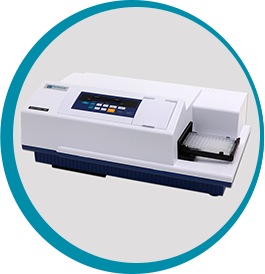
The Best Microplate Readers According to our Product Reviewers
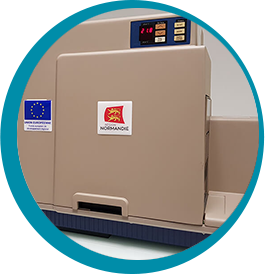
The University of Rouen in Normandy uses the SpectraMax iD3 and FlexStation 3 for calcium studies, and in its teaching laboratories.
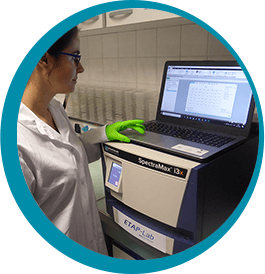
ETAP Lab use the SpectraMax i3x to advance neurodegenerative disease research
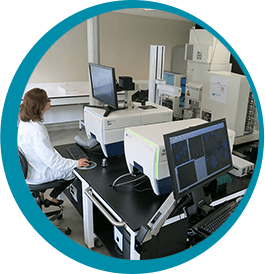
HCS Pharma uses ImageXpress Micro Confocal Systems for phenotypic screening of physiologically relevant 3D cell models
Applications and Research
Find an extensive collection of application notes, research, and detection technology related to microplate reader assays and applications including ELISAs, western blots, and protein and nucleic acid detection.
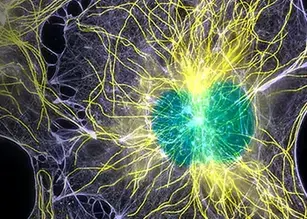
Cellular Signaling
Cellular signaling allows cells to respond to their environment and communicate with other cells.…

Microbiology and Contaminant Monitoring
Microbes, including bacteria, have been estimated to make up about 15 percent of the earth’s…

Cell Health: Viability, Proliferation, Cytotoxicity, and Cellular Function
Cell viability assays measure various cell markers, such as ATP or metabolic enzyme activity, as…

Protein Detection, Quantitation and Analysis
Protein detection, quantitation, and analysis are central to investigating a wide variety of…

Nucleic Acid (DNA/RNA) Detection, Quantitation, and Analysis
Nucleic acids are large, complex biomolecules found in cells. They serve as the genetic material of…
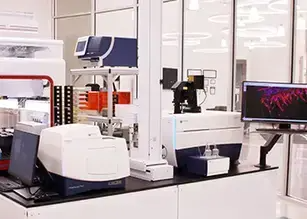
Organoid Innovation Center
The new Organoid Innovation Center at Molecular Devices combines cutting-edge technologies with…

Food & Beverage
From customized work cells for cellular agriculture to quality and safety testing, the Molecular…

Fluorescence Polarization (FP)
Fluorescence polarization (FP) is a technique that is widely used to monitor binding events in…
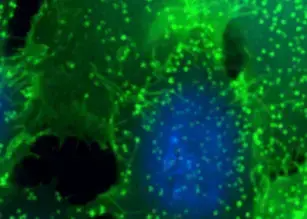
TRF, TR-FRET & HTRF
Learn about TRF and TR-FRET (HTRF) detection and kinase assays, cellular signaling pathways,…

Absorbance
Learn about absorbance detection and ELISAs, nucleic acid and protein quantitation, and microbial…

Fluorescence
Learn about fluorescence detection and cell viability and nucleic acid quantification applications.

Luminescence
Learn about luminescence detection and dual luciferase reporter gene, GPCR, and BRET applications.

Western Blot
Learn about western blotting, a popular technique used for protein detection and quantitation.

Enzyme-Linked Immunosorbent Assay (ELISA)
ELISA (enzyme-linked immunosorbent assay) is a method used to quantitatively detect an antigen…
Related Products and Services
Complete solution of high-performance labware from microplate stackers and washers to a broad range of consumables and assays.
